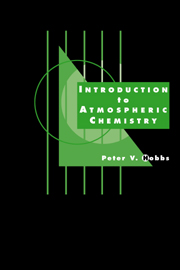Book contents
- Frontmatter
- Contents
- Preface
- 1 Evolution of the Earth's atmosphere
- 2 Half-life, residence time, and renewal time of chemicals in the atmosphere
- 3 Present chemical composition of the atmosphere
- 4 Interactions of solar and terrestrial radiation with atmospheric trace gases and aerosols
- 5 Sources, transformations, transport, and sinks of chemicals in the troposphere
- 6 Atmospheric aerosols
- 7 Cloud and precipitation chemistry
- 8 Tropospheric chemical cycles
- 9 Air pollution
- 10 Stratospheric chemistry
- Appendix I Exercises
- Appendix II Answers to exercises in Appendix I and hints and solutions to the more difficult exercises
- Appendix III Atomic weights
- Appendix IV The International System of Units (SI)
- Appendix V Some useful numerical values
- Appendix VI Suggestions for further reading
- Index
6 - Atmospheric aerosols
Published online by Cambridge University Press: 05 June 2012
- Frontmatter
- Contents
- Preface
- 1 Evolution of the Earth's atmosphere
- 2 Half-life, residence time, and renewal time of chemicals in the atmosphere
- 3 Present chemical composition of the atmosphere
- 4 Interactions of solar and terrestrial radiation with atmospheric trace gases and aerosols
- 5 Sources, transformations, transport, and sinks of chemicals in the troposphere
- 6 Atmospheric aerosols
- 7 Cloud and precipitation chemistry
- 8 Tropospheric chemical cycles
- 9 Air pollution
- 10 Stratospheric chemistry
- Appendix I Exercises
- Appendix II Answers to exercises in Appendix I and hints and solutions to the more difficult exercises
- Appendix III Atomic weights
- Appendix IV The International System of Units (SI)
- Appendix V Some useful numerical values
- Appendix VI Suggestions for further reading
- Index
Summary
Apart from cloud and precipitation particles, which have relatively large sizes, the Earth's atmosphere consists a mixture of gases, small solid particles, and small liquid droplets. Mixtures of air with small solid particles and small droplets are called aerosols The small particles and droplets themselves (called aerosol particle, but often loosely referred to as simply aerosols) are important not only in air chemistry but in determining visibility, the formation of cloud particles, atmospheric radiation, and atmospheric electricity. In this chapter we will be concerned primarily with chemical aspects of atmospheric aerosols, but we will start by describing two of their important physical attributes, namely, their concentrations and size distributions.
Aerosol concentrations and size distributions
Total number and mass concentrations
One of the oldest and most convenient techniques (which in various modified forms is still in use) for counting the number concentrations of atmospheric aerosols is the Aitken1 nucleus counter. In this instrument, humid air is expanded rapidly so that it cools and becomes supersaturated by several hundred percent with respect to water. At these high supersaturations, water condenses onto virtually all of the particles in the air to form a cloud of small water droplets in the chamber of the counter. The number concentration of droplets in this cloud (which is close to the total number concentration of aerosol particles) can be determined automatically by optical techniques or by allowing the droplets to settle onto a substrate where they can be counted. The concentration of aerosol particles measured with an Aitken nucleus counter is referred to as the Aitken (or condensation) nucleus count (CN count for short).
- Type
- Chapter
- Information
- Introduction to Atmospheric Chemistry , pp. 82 - 110Publisher: Cambridge University PressPrint publication year: 2000

